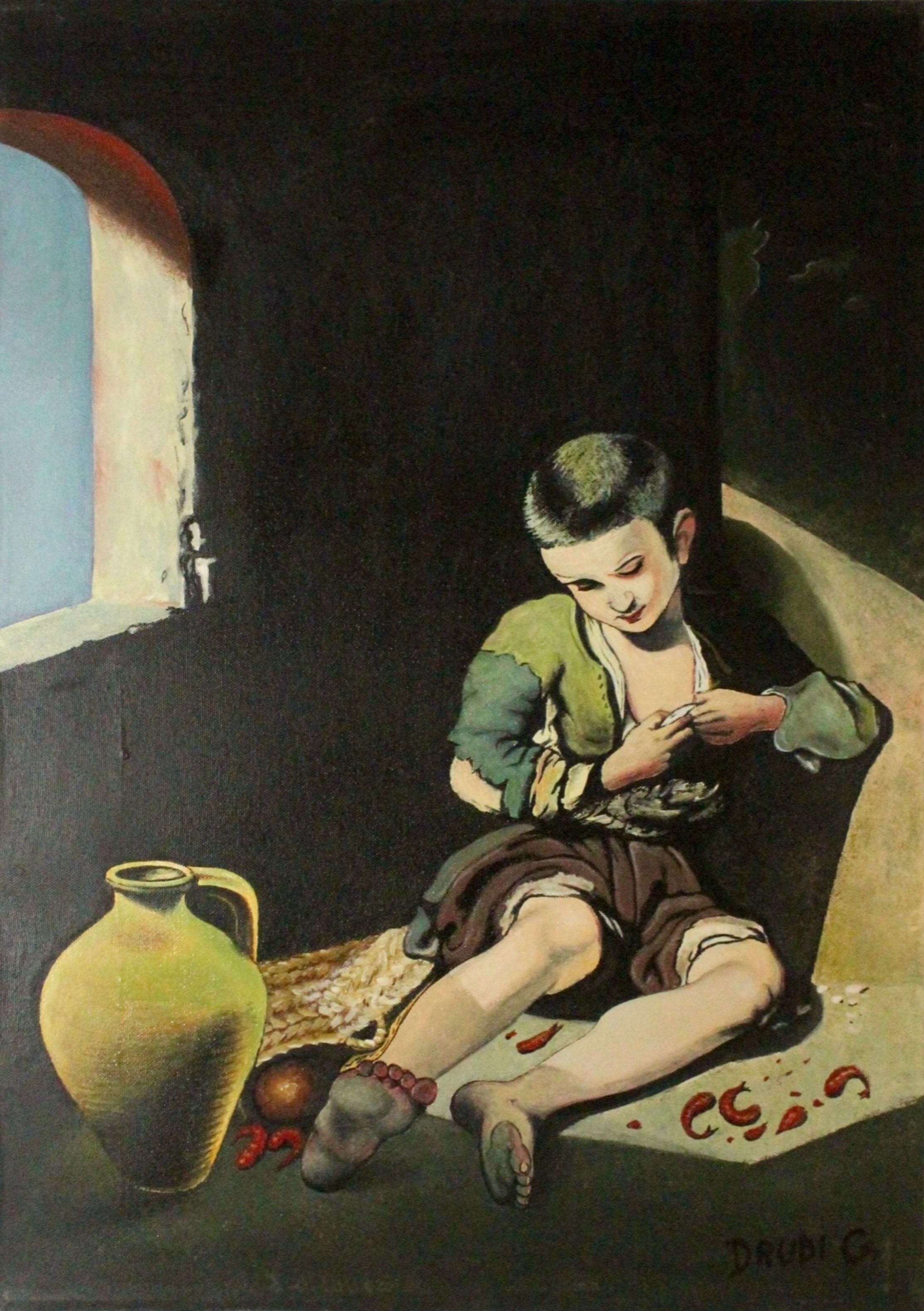THE LITTLE BEGGAR
1977, 50x70cm, Tempera on canvas with glossy spray fixative

A little beggar peeling shrimp.
“The Little Beggar” is a work that portrays a young boy seated in a bare space. The child, dressed in simple clothes of green and brown, is sitting with his legs stretched out on the floor. His hands are in front of his chest as he is focused on peeling shrimp. The room is pervaded by darkness, interrupted only by a window on the left that lets in the daylight. Next to the boy, on the floor, there is a large yellow jar. Scattered around his feet are some red shrimp, some already peeled and others still to be prepared. The atmosphere is melancholic and intimate, emphasized by the contrast between the darkness of the room and the light that partially illuminates the subject.
Painting technique:
The work is created with oil colors on canvas, characterized by a limited but effective palette. The artist uses pronounced chiaroscuro contrasts, with the figure of the child emerging from the surrounding darkness thanks to touches of light. The colors are bright but controlled: the dark tones of the background predominate, the green of the child’s clothes, the warm tones of yellow and ochre of the jar, and the points of bright red of the shrimp. The brushstroke appears relatively smooth and controlled, with a realistic rendering.
Symbolic elements or hidden meanings:
The title “The Little Beggar” immediately suggests the social condition of the represented child. Poverty is evoked by the bare and dark environment, a symbol of deprivation and solitude. The large empty jar can symbolize the scarcity of food. The shrimp that the boy is peeling represent one of the few foods available to him, perhaps collected or received as alms. The activity of peeling shrimp suggests the necessity to procure food with one’s own hands, a symbol of forced autonomy at a young age. The light entering from the window could symbolize hope or a connection with the outside world. There is a silent dignity in his posture and concentration that contrasts with the misery of the surrounding environment.
Conclusion:
“The Little Beggar” is a work that manages to communicate with emotional power the condition of child poverty without falling into sentimentalism. Through a skillful use of chiaroscuro and an essential composition, the artist creates a strong emotional impact, inviting the observer to reflect on social inequalities and the vulnerability of childhood. The image of the child peeling shrimp adds an element of daily life that makes the scene even more touching and real. The work fits into the tradition of social painting that uses art as an instrument of denunciation, but it does so with subtlety and respect for the dignity of the represented subject.

A little beggar peeling shrimp.
“The Little Beggar” is a work that portrays a young boy seated in a bare space. The child, dressed in simple clothes of green and brown, is sitting with his legs stretched out on the floor. His hands are in front of his chest as he is focused on peeling shrimp. The room is pervaded by darkness, interrupted only by a window on the left that lets in the daylight. Next to the boy, on the floor, there is a large yellow jar. Scattered around his feet are some red shrimp, some already peeled and others still to be prepared. The atmosphere is melancholic and intimate, emphasized by the contrast between the darkness of the room and the light that partially illuminates the subject.
Painting technique:
The work is created with oil colors on canvas, characterized by a limited but effective palette. The artist uses pronounced chiaroscuro contrasts, with the figure of the child emerging from the surrounding darkness thanks to touches of light. The colors are bright but controlled: the dark tones of the background predominate, the green of the child’s clothes, the warm tones of yellow and ochre of the jar, and the points of bright red of the shrimp. The brushstroke appears relatively smooth and controlled, with a realistic rendering.
Symbolic elements or hidden meanings:
The title “The Little Beggar” immediately suggests the social condition of the represented child. Poverty is evoked by the bare and dark environment, a symbol of deprivation and solitude. The large empty jar can symbolize the scarcity of food. The shrimp that the boy is peeling represent one of the few foods available to him, perhaps collected or received as alms. The activity of peeling shrimp suggests the necessity to procure food with one’s own hands, a symbol of forced autonomy at a young age. The light entering from the window could symbolize hope or a connection with the outside world. There is a silent dignity in his posture and concentration that contrasts with the misery of the surrounding environment.
Conclusion:
“The Little Beggar” is a work that manages to communicate with emotional power the condition of child poverty without falling into sentimentalism. Through a skillful use of chiaroscuro and an essential composition, the artist creates a strong emotional impact, inviting the observer to reflect on social inequalities and the vulnerability of childhood. The image of the child peeling shrimp adds an element of daily life that makes the scene even more touching and real. The work fits into the tradition of social painting that uses art as an instrument of denunciation, but it does so with subtlety and respect for the dignity of the represented subject.